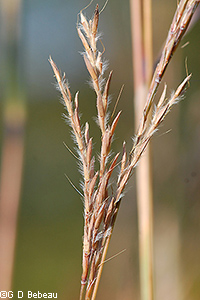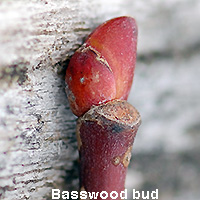
Effective coloring in the Wild Garden that is not due to flowers.
by Eloise Butler, from Early History of the Native Plant Reserve, Dec. 1915
Note: Since Eloise Butler's time, the scientific names of plants and the classification of plant families has undergone extensive revision. In brackets within the text, have been added when necessary, the revised scientific name for the references she used in her article. Nomenclature is based on the latest published information from Flora of North America (Ref.#W7) and the Checklist of the Vascular Flora of Minnesota (Ref.#28C). Other information in brackets may add clarification to what she is saying. Photos have been added - none were in the original article.
I had decided to write a little on this subject before reading in the November Garden Magazine, Mr. E. H. Wilson’s delightful paper on “The Glory of the Autumn.” He says, “No scene in nature is more delightful than the woods of eastern North America in the fullness of their Autumn splendour.” The forest region of Minnesota may be included in this eulogy . . .
The first note of the brilliant color of the waning year is struck by the red maple, Acer rubrum, which is abundant in all stages of growth in the wild garden. Its poignant beauty persists until after the first heavy frosts. In the spring, this tree glows brilliant in fruit as well as in flower. When the maple leaves fall, the oaks begin to put on their gorgeous crowns in many shades of red, bronze, and russet brown, set off by the yellow leaves of the birch and poplars, the gleaming white stems of the birches and the dark green foliage of the tamarack. The white oaks lend a distinctive tint of a peculiarly rich mulberry red. Nature makes a lavish use of pigments on many of the shrubs and low bushes. The sumachs cover the landscape here and there with floods incarnadine [pale red to blood red] (photo); and the woodbines, or Virginia Creepers, are trailing clouds of glory; the viburnums show deep red; the dark pink leaves of the waahoo [Wahoo - Euonymus atropurpureus] are succeeded by fruit-tassels of coral pink and red; the foliage of the black currant, Ribes floridum [Ribes americanum], is rimmed and streaked with red; and the blackberry’s vicious prickles are forgiven when its leaves are like the petals of damask rose.
The ground blazes where the blueberry appears, or the malignant poison ivy, and flecks of crimson or scarlet mark the position of Flowering Spurge, Euphorbia corollata and of Epilobium coloratum [Willowherb]; and the miniature poinsettia, Euphorbia heterophylla [Wild Poinsettia], decks its green bracts with a scarlet blotch at the base.
All this brilliancy is enhanced in the garden by the young evergreen trees, the evergreen ferns and trailers in the swamp, and by the persistent green of some of the deciduous trees and shrubs, like locust and Ceanothus; and variety is added by the mottled leaves of Geum macrophyllum [Largeleaf Avens]; Heuchera americana [Alumroot]; and the rosettes of Evening Primrose, while the patches of Epipactis, of three species [Helleborines], in their white tracery are a never ending delight.

Fruits often excel flowers in richness of color. I have already mentioned the fruits of red maple and wahoo. To classify by color, various shades of red are represented by the following: Sambucus racemosa [Red Elderberry - photo], appears early in summer, a veritable Queen of Sheba against a background of green; the birds scarcely allow us a glimpse of the sweet Juneberry, and the children cull the fragrant strawberries on the hillsides; the brilliant pomes of the hawthorns and the rosehips endure for a longer period, also the fruits of mountain ash. The red raspberry disappears quickly, but not in the same way; the Strawberry-blite, Chenopodium capitatum; or the Red Baneberry; the fruits of Trillium; Smilacina [False Solomon’s Seal - Maianthemum]; Jack-in-the-pulpit; Wild Calla; Green Dragon Twisted Stalk; Bearberry; Coral Berry, Ilex verticillata [Winterberry]; Canadian holly; Lonicera; and of the vines - Bittersweet; Matrimony vine; and Solanum dulcamara [Climbing Nightshade]. The bright berries of Panax quinquefolius [American Ginseng] may not escape the ginseng hunter, but he passes by the smaller P. trifolius [Dwarf Ginseng].

Birds and children quickly despoil the various cherries and the yellowish red wild plum and the buffalo berry of their fruits, but the swamp affords some protection from children to Bunchberry, (Cornus canadensis); Cranberries; May Apple, Mitchella repens [Partridge Berry]; Dewberry; Red currant. The introduced Boxberry, Gaultheria procumbens [Eastern Teaberry]; and Mountain cranberry [Lingon-berry], Vaccinium vitis-idaea, are too sparse to attract attention. The large, showy thyrsi of the Staghorn Sumac must not be omitted from this list; neither many vermilion-hued fungi -- the red cup of early spring, Sarcoscypha coccinea; the Swamp Boletus pictus [Boletus edulis]; the little Hygrophorus conicus [Witch’s Hat]; rosy russulas, and the deadly Amanita muscaria. Very pleasing, too, are the red tipped lichens, species of Cladonia. I had nearly forgotten the berry-like fruit of “Ground Hemlock,” Taxus canadensis [American or Canada Yew]; and the beautiful High-bush Cranberry [photo], delicious preserves for the Bohemian waxwing and jelly for humans.

Among blue or purple fruits we have the wonderful blues of Cohosh [photo], Clintonia, of Cornus amomum [Silky Dogwood]; C. circinata [C. rugosa - Round-leaved Dogwood]; C. alternifolia [Pagoda Dogwood]. Other blues, lighter or darker, are blueberries, grapes, Moonseed (Menispermum), fruits of Woodbine, Juniper, Lonicera caerulea [Lonicera villosa, Blue Honeysuckle]; Viburnum pubescens [Viburnum dentatum, Southern Arrowwood].
Dark purple or black fruits: Buckthorn, Rhamnus alnifolia [Alderleaf Buckthorn]; blackberry; Thimbleberry, Rubus occidentalis; Sheepberry; Smilax of several species [Carrion Flower and Greenbriars]; Black currant, Ribes floridum [Ribes americanum]; Aralia nudicaulis [Wild Sarsaparilla]; Aralia racemosa [American Spikenard]; Solomon’s seal; Gooseberry; Chokeberry; Sambucus canadensis [Common or Canada Elderberry]; Hackberry, purplish-brown in color.
Yellow fruits: Crataegus punctata [Dotted Hawthorn]; Horse Gentian, Triosteum perfoliatum; Deerberry; Chokecherry var. leucocarpa [Prunus virginiana var. leucocarpa - usually considered an amber color version of P. virginiana]

Greenish white or white fruits: Snowberry; Creeping Snowberry, Chiogenes hispidula [Gaultheria hispidula]; Wolfberry; White baneberry; Poison Ivy; Poison sumach; Cornus asperifolia [Toughleaf dogwood]; C. Baileyi [a cultivar of Cornus sericea - Redosier Dogwood]; C. stolonifera [Cornus sericea - Redosier Dogwood]; C. paniculata [Cornus racemosa - Gray Dogwood]. The fruits of white baneberry and Cornus paniculata [photo] are given additional beauty by their red stalks. Under this head may be placed the fluffy appendages of dry fruits or seeds which add in their season a conspicuous note to the landscape: Clematis; Cotton grass, Eriophorum angustifolium; the pappus of many composites, as dandelion, thistle, Senecio [the ragweeds], [and many others] and the appendages of seeds, as willow and milkweed.
Quaker grey and silver are furnished by many of the Artemisias, by the foliage and fruit of the Silverberry, Elaeagnus argentea [Elaeagnus commutata]; by Poverty grass, Hudsonia tomentosa; Cudweed; and Salix candida [Sageleaf Willow].

The tones of grasses are potent to charm and almost defy classification. I will mention a few of my favorites without attempting to define the color: Indian Grass, Sorghastrum nutans; Andropogon scoparius [Schizachyrium scoparium - Little Bluestem]; A. furcatus [Andropogon gerardii - Big Bluestem - photo]; Eragrostis pectinacea [Tufted Lovegrass]; Phragmites communis [Phragmites australis - Common reed]; Bromus ciliatus [Fringed Brome]; Glyceria canadensis [Rattlesnake Manna grass]; and of the sedges: Scirpus validus [Soft-stem Bullrush]; S. sylvanticus [Scirpus expansus - Woodland Bullrush], and S. atrovirens [Green Bullrush].

Our Oaks, except Quercus macrocarpa, retain their leaves in winter, and though turned to dusky brown, still give variety to the landscape. When the birds have eaten the fruit and the deciduous trees and shrubs are bare, the stems of dogwoods and roses make a cordon of red and purple about the garden swamp, and the willows light up gray days with sunshine-yellow. The sense of color can also be gratified in noting the gradations of tints in trunk, branches and outmost twigs. It is interesting to distinguish trees by the color of their bark as well as by their leaf forms and general architecture. The twigs of trees show soft, bright tints, and there is much individuality in the color of buds. To note but a few: The mouse-colored buds of Box Elder; the Bitter nut, sulfur tinted; the American elm, appleseed brown; those of Basswood like red shellac [photo]. Of course, the color of tree trunks varies with age. Everyone admires the conspicuous bolls of the White Birch, but those of the Yellow Birch like old brass; the Mountain Ash like copper; the Red Maple is ash-pink; the Aspen, pale greenish gray.
I particularly love the color tones of spring when the buds are beginning to unfold. They are more difficult to characterize, and I wish to renew my impressions before I make the attempt.
Note: Many of the plants mentioned in this article have an information sheet, with photos and descriptions, posted on this website. Use these links to locate them: Common Name List - Scientific Name List.